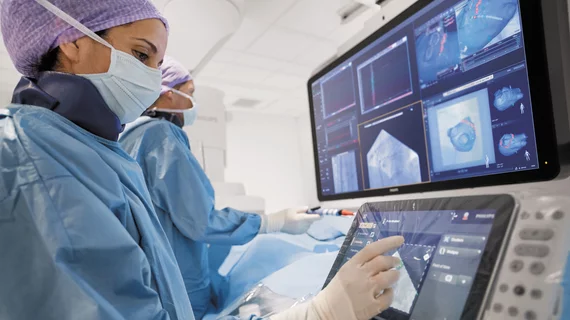Women only account for a small percentage of the interventional radiology physician workforce, but their numbers appear to be increasing, according to a new analysis published March 2.
Between 2017 and 2021, the percentage of female interventional trainees nearly doubled, from 10.5% up to 20.3%, medical school demographic data show. Recent initiatives have helped to pull the numbers upward, but barriers appear to persist, experts wrote in Academic Radiology [1].
“There are many reported factors contributing to this gender gap, including radiation exposure fears and difficulties with work-life balance exacerbated by policies and traditions at both the societal and institutional levels,” Julie Kim, MD, with Weill Cornell Medicine in New York, and co-authors concluded. “Bolstered by various initiatives focused on supporting women in IR, female representation in IR demonstrates a slow but steady increase from 2007 to 2021.”
The study’s authors pinpointed the relatively recent creation of the integrated IR residency program as a “transformative structural shift” toward addressing the gender gap. Launched with the 2016-2017 academic year, the program has trainees splitting time between diagnostic and interventional radiology.
This pathway has become the “dominant” source of IR trainees over the past seven years, leaping from just 4.4% in the first year up to more than 76% in 2020-2021. Between 2017-2021 after integrated IR debuted, the percentage of female residents in the specialty leapt from 13.3% to 22%—19.1% year-over-year growth, the authors noted—with a higher numbers when compared to the traditional independent-IR pathway.
Kim et al. believe the 2019-2020 academic year was an “influential point in time,” with gradually rising female IR physician numbers beginning to become more statistically significant. These increases appear “unparalleled” in medicine, they note, with integrated IR logging higher average yearly growth among female trainees than almost any other peer specialty (interventional cardiology was one exception).
Besides the integrated pathway, other initiatives from the Society of Interventional Radiology also have helped increase the numbers, the authors added. Those include webinars on topics such as work-life balance, newsletters highlighting women in the IR specialty, and an official statement from the society supporting parental leave.
“These initiatives, and others like them, have contributed to the recently growing proportion of women in IR, and while encouraging, there still is a continued need for such resources, in addition to greater awareness of said resources, to further bridge the gender gap,” the authors advised.

